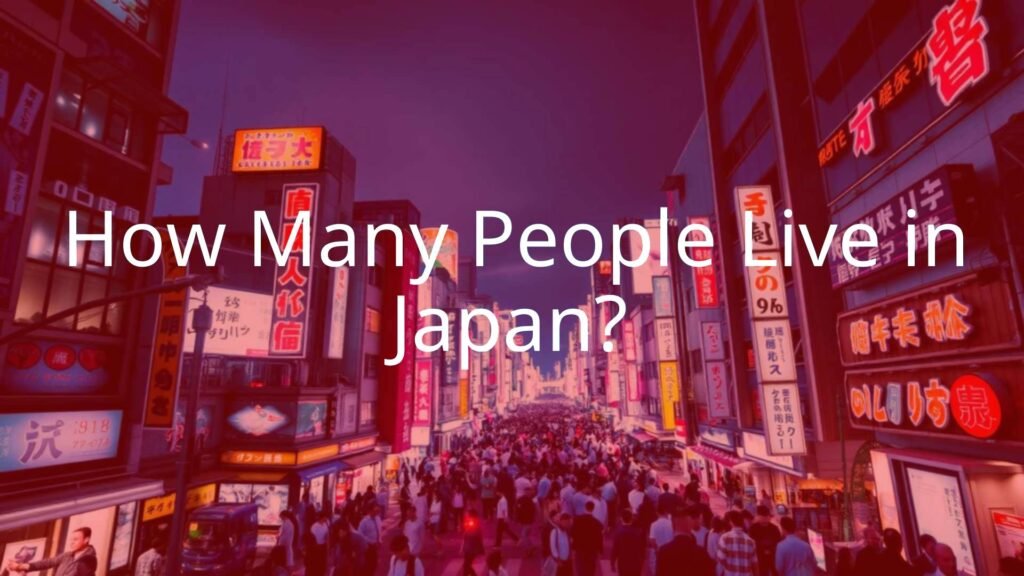As of July 2, 2025, Japan’s population is estimated to be about 123,099,989. This number comes from Worldometer’s update of the latest United Nations data, giving us a current look at how many people live in Japan. Japan is now the 12th most populated country in the world and makes up around 1.50% of all people worldwide. However, Japan’s population keeps slowly shrinking, which is having big effects on the country’s society and economy.

In this article, we look closely at Japan’s population today, see how people are spread across different areas and cities, check historical trends, and see what the future might hold. We’ll also answer common questions about Japan’s population and the special challenges the country faces.
Current Population of Japan
How Many People Live in Japan Today?
Japan, known for its unique culture and advanced technology, currently has slightly over 123 million people. As of March 28, 2025, the population was 123,271,281, according to Worldometer using recent United Nations data. Japan is the 12th largest country by population, with 1.50% of the world’s people living there.
Looking ahead, the middle of 2025 is expected to see Japan’s population at 123,103,479. This number comes from the U.N. Department of Economic and Social Affairs – Population Division’s 2024 update. Japan covers an area of 364,555 km² (140,755 sq. miles), meaning there are 338 people for every square kilometer (or 875 per square mile).

Japan Population Clock: Live Numbers
If you want to see how Japan’s population changes in real time, the Japan Population (Live) counter updates the number constantly. This tool uses Worldometer’s system to update data straight from the United Nations Population Division, tracking the ongoing changes-like births, deaths, and movements in and out of the country.
These live statistics show that in 2025, Japan’s population is predicted to shrink by about 0.52% for the year, lowering the population by roughly 649,562 people. Even though there’s a net gain from migration of about 140,579 people for the year, deaths are still greatly outnumbering births, which keeps pushing the country’s numbers down. This ongoing change is a big part of what makes Japan’s population situation unique.
Population by City and Region in Japan
Main Cities by Population
While the population is getting smaller overall, most people in Japan live in cities. Tokyo, the capital and biggest city, has 8,336,599 people. But greater Tokyo, including the wider metropolitan area, has over 37 million people-making it the largest metropolitan area in the world.
Here are the other major Japanese cities by population:
| City | Population |
|---|---|
| Yokohama | 3,761,630 |
| Osaka | 2,753,862 |
| Nagoya | 2,191,279 |
| Sapporo | 1,973,832 |
| Fukuoka | 1,603,543 |
| Kawasaki | 1,531,646 |
| Kobe | 1,522,188 |
| Kyoto | 1,463,723 |
| Saitama | 1,324,854 |
| Hiroshima | 1,199,391 |
These cities are not only packed with people-they are important for business, culture, and daily life in Japan.

Population Density by Prefecture
Most of Japan is mountainous, so people live close together in the flat and coastal areas. The average is about 338 people per square kilometer, but this changes a lot depending on the location. Japan’s four main islands-Honshu, Hokkaido, Kyushu, and Shikoku-have about 97% of all the country’s people.
Honshu, the largest island where cities like Tokyo, Yokohama, Osaka, and Nagoya are located, has the most people per square kilometer: about 450 as of 2010. Hokkaido, to the north, is much less crowded with only about 64.5 people per square kilometer. Only about 11.2% of Japan’s land can be used for farming, so nearly everyone lives in busy towns and coastal areas.
Urban vs. Rural Population
Japan’s people mostly live in cities-and even more so each year. In 2025, around 93.13% (about 114,645,589 people) live in towns and cities. In 2023, that number was already at 92%. People keep moving to cities for work and school, so the country’s urban population keeps growing while the countryside shrinks.
This trend causes challenges. Cities get more crowded, and services are stretched thin. Meanwhile, country towns lose people, get older, and find it hard to keep up their schools, hospitals, and shops. Although the total number of people in Japan is going down, cities are still full and active.

Japan Population Trends Over Time
Japan Population (1950-2025): Main Changes
Japan’s population has changed a lot since 1950. Back then, there were about 83,025,820 people. After World War II, families grew quickly, and Japan’s economy also took off. In 1965, the population went over 100 million. Growth continued, mostly because of more births and people living longer.
The highest number was in the early 2010s: about 128 million people. In 2010 the population was 128,185,275, and in 2015 it was 127,275,872. Since then, the numbers have gone down. By 2020, it was 126,304,543, and the 2025 estimate is 123,103,479. This long-term pattern shows how Japan shifted from quick growth to losing people each year.

| Year | Population |
|---|---|
| 1950 | 83,025,820 |
| 1965 | 100,916,019 |
| 2010 | 128,185,275 |
| 2015 | 127,275,872 |
| 2020 | 126,304,543 |
| 2025 (est.) | 123,103,479 |
Population Peak and Decline: When Did It Start?
Japan’s population hit its highest point in the early 2010s, near 128 million people. Since then, the total number has kept dropping. This is happening for clear reasons: very few babies are being born, and more people are living longer lives.
Japan’s birth rate is 1.23 children for every woman in 2025, much lower than the 2.1 needed to keep the population steady. At the same time, people in Japan live a long life-an average of 85.0 years. Many Japanese are now over age 65, making the population older overall. The middle age (median) is now 49.8 years-the oldest for any country. This means the number of people dying is now higher than the number of babies being born, so the country’s population keeps getting smaller and older each year.
Japan Population Forecast
What Will Happen to Japan’s Population Next?
- 2025: 123,103,479
- 2030: 119,584,121
- 2035: 115,876,149
- 2040: 112,158,303
- 2045: 108,551,995
- 2050: 105,123,167
The population is expected to drop by about 0.5-0.65% each year, which means Japan could lose hundreds of thousands of residents every year for the next few decades. This will affect the country’s economy, society, and worldwide role.
Why Is Japan’s Population Falling?
Japan’s falling numbers are mainly because of two things: low birth rates and an aging population. The average number of children a woman in Japan will have is only 1.23, far below the 2.1 needed to keep numbers stable. This is affected by things like cost of living, job demands, different views on family, and not enough help for parents with young children.
Japanese people also live a long time-85.0 years on average-which means there are more elderly people than young people. Right now, about 29.3% of Japanese are over 65. There aren’t enough young people joining the workforce or having children to balance out the growing number of retirees. Even though more people are moving into Japan than leaving (net migration is +140,579 in 2025), it isn’t enough to stop the overall decrease.
Frequently Asked Questions: Japan’s Population
Why Is Japan’s Population Getting Smaller?
Japan’s numbers are shrinking mainly because very few children are being born and people are living much longer. Each generation isn’t having enough children to replace themselves, which means there are fewer young people every year while the number of elderly keeps growing. More young people are also staying single or waiting longer to marry and have kids. Raising children is expensive and job demands are high, so families often choose to stay small.
How Does Japan’s Population Compare to Other Countries?
With about 123 million people, Japan is the 12th largest country by population. That’s far fewer than China or India (both with over a billion people), and fewer than the United States (almost 340 million). Unlike some other major countries, Japan’s population is shrinking.
Japan is also one of the most crowded countries, with 338 people per square kilometer, but most people live in small, flat parts of the country. Japan also has more elderly people, by percent, than anywhere else-almost 30% are over 65. In contrast, many growing countries have more young people and higher birth rates. Japan’s population is both shrinking and getting older, making its situation very different from many other countries.
- What Is a Maiko? - July 13, 2025
- What Does Domo Arigato Mean? - July 12, 2025
- What Does Naruto Mean? - July 12, 2025









